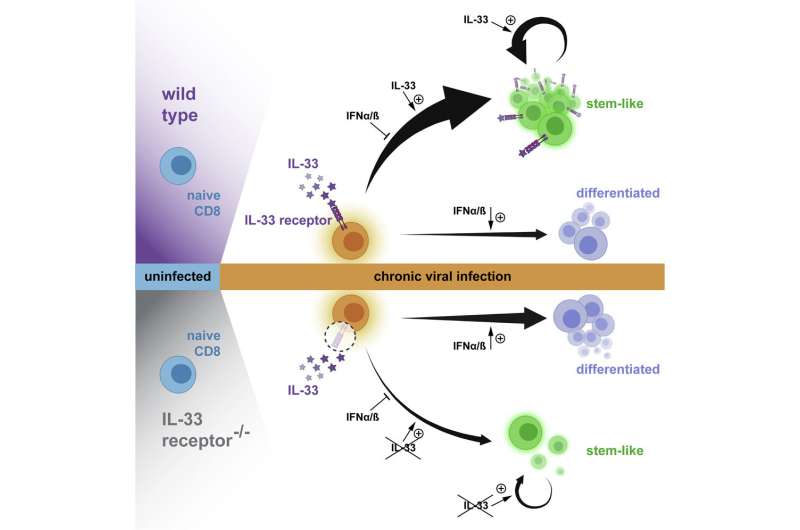This article has been reviewed according to Science X's editorial process and policies. Editors have highlighted the following attributes while ensuring the content's credibility:
fact-checked
peer-reviewed publication
trusted source
proofread
How IL-33 plays a key role in enabling the marathon runners of the immune system

When it comes to chronic infections and cancer, a particular type of immune cell plays a central role in our defenses. Researchers at the University of Basel have uncovered the key to the tenacity of these immune cells in coping with the marathon that is fighting a chronic infection. Their results lay the foundations for more effective therapies and vaccination strategies.
Infected and abnormal cells have to go, and as quickly as possible, before any more damage is done. This is the task of what are known as cytotoxic T cells. The question of how these cells fight off chronic infection is under investigation by the team surrounding Professor Daniel Pinschewer at the Department of Biomedicine of the University of Basel, in collaboration with several national and international partners.
"These T cells can become specialized in two different ways: either as a kind of sprinter or as marathon runners," explains Pinschewer. "However, the latter can also convert into sprinters at any time, in order to stamp out an infection."
Chronic infections are a special case: The T cells are activated and a strong inflammatory response occurs at the same time. "This tends to 'shock' the T cells into developing into sprinters, which can only intervene effectively in the short term to remove infected cells," says the virologist. "If all T cells behaved like that, our immune defenses would break down pretty soon."
In their study published in the journal Immunity, the researchers examined how, in spite of this, the immune system is still able to provide enough T cells for the endurance race against chronic infections. According to their results, a biological messenger called interleukin-33 (IL-33) plays a key role. It allows the T cells to remain in their "marathon runner" state.
"IL-33 takes away the shock of the inflammation, so to speak," explains Dr. Anna-Friederike Marx, lead author of the study.
In addition, the biological messenger causes the marathon T cells to proliferate, so that more endurance runners are available to combat the infection. "Thanks to IL-33, there are enough cytotoxic T cells around for the long haul that can still pull off a final sprint after their marathon," says Marx.
The findings could help improve the treatment of chronic infections such as hepatitis C. It is conceivable that IL-33 could be administered to support an effective immune response. Thinking along the same lines, IL-33 could be one key to improving cancer immunotherapy, to enable T cells to wage an efficient and long-lasting offensive against tumor cells.
More information: Anna-Friederike Marx et al, The alarmin interleukin-33 promotes the expansion and preserves the stemness of Tcf-1+ CD8+ T cells in chronic viral infection, Immunity (2023). DOI: 10.1016/j.immuni.2023.01.029





















